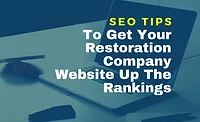6 SEO Tips to Get Your Restoration Business Noticed
SEO may feel like speaking Greek, but these tips make it simple to go for the gold
Leave your frustration with Internet marketing at the door. Forget about all of the emails and voicemails promising to get you on the first page of Google. Your online presence is more in your control now than it has ever been. The more you know, the more successful your online strategies can be.
Keeping up with the latest and never ending SEO trends can seem daunting, but recent algorithm updates have favored small, local businesses and helped to level the playing field when it comes to creating an effective online presence. The cost prohibitive and complicated Internet marketing strategies of the past are being replaced by more cost-effective inbound strategies that are easier for business owners to understand and implement.
Here are 6 SEO tips that can get you moving in the right direction:
1. Mobile-Friendly is a Must
Your clients are searching from a mobile device. That is a fact that isn’t going to change. It is estimated that in 2015 there will be as many as 50 billion local searches using mobile devices. Google’s recent algorithm update labeled “mobile-geddon” focuses on demoting websites that don’t comply.
“It’s probably the most significant change that Google Inc. has ever made to its mobile search rankings,” said Matt McGee, editor-in-chief for Search Engine Land, a publication that follows every change that Google makes.
What you can do:
If you are not sure if your site meets the mobile-friendly requirements you can test it at www.google.com/webmasters/tools/mobile-friendly. This test will analyze your URL and report if the page has a mobile-friendly design.
2. Content Really is King
The last several algorithm updates have pointed toward the importance of content. Hummingbird, released in 2014, specifically addressed the value of content. Not just any content will do. Current and relevant content is the key. The quality of the content is of most importance.
One key to quality content is to avoid using duplicate content. Moz.com defines duplicate content as “content that appears on the Internet in more than one place.”
To provide the best search experience, search engines will rarely show multiple duplicate pieces of content and thus, are forced to choose which version is most likely to be the original—or best.
What you can do:
The most important thing to do is make sure your website has a blog. This is a great place to regularly add content that focuses on keywords that are important to you. Remember, you are really speaking to two separate audiences with your content. The first audience is your target audience – real live potential customers. Provide content that will be useful and interesting to them. Blog articles are great links to share on your social media to drive traffic back to your website.
The second audience you are speaking to is the robots who crawl your site indexing pages for the search engines. They are looking for content intended to benefit readers and tell what your site is about. The old practice of stuffing an abundance of keywords into your content is outdated. Be genuine and be authentic. You will be rewarded.
3. Be Social
Your presence on social media is about much more than just posting on Facebook or Twitter. Social signals now directly affect your SEO. That’s right, your rankings can benefit for integrating your social platforms and your website. You can also lock up positions in the Google rankings with your Facebook page, Twitter account, and YouTube videos.
What you can do:
If you want to give yourself an advantage use social media. Share links to your blog, share inspirational and motivational images that have a broad appeal, give expert tips and advice. The best thing you can do is be consistent. Over time this can help pages on your website rank.
4. Build Links
Gone are the days when big companies can pay gobs of money to build tons of random links and buy their rankings. Proper link building is still important, but the difference is in how search engines interpret those backlinks.
What can you do:
You can check how many links you have and compare it to your competitors. There are many tools available to do this. Check out www.moz.com to get an idea of where you sit. Link building can be a little tricky, not to mention time consuming, so it may be something you want to consult with professionals on.
5. Visual-Based SEO
That’s just a fancy way of saying use more video and graphics! Top performing website pages often include high quality, original graphics and videos. High quality does not mean professional and expensive. It’s about delivering valuable content.
According to YouTube it has over a billion users and every day people watch hundreds of millions of hours on YouTube – don’t you think yours should be one of them?
What you can do:
If you don’t have a YouTube account set one up. Don’t be intimidated by video. You can shoot testimonials, tips for your customers, and about us videos all from your iPhone. Start shooting and posting video today. We live in a visual world, the faster you adjust to this the sooner your visual content will be found.
6. Claim Your Listings
Google Places or your Google map listing can be a huge source of organic traffic. You want to take the time to claim, verify and optimize your listing.
“When it comes to digital marketing and SEO for your business, it’s important to look beyond just your website,” said Rachel Lindteigen of Search Engine Land. “For local businesses, a strong online marketing effort requires an investment in local directories, maps and review sites, too.”
What you can do:
You can get started by going to https://www.google.com/business to learn more about claiming and verifying your listing.
Although these strategies are not going to yield results overnight, with time it is possible to implement an effective strategy without breaking the bank.
Looking for a reprint of this article?
From high-res PDFs to custom plaques, order your copy today!







